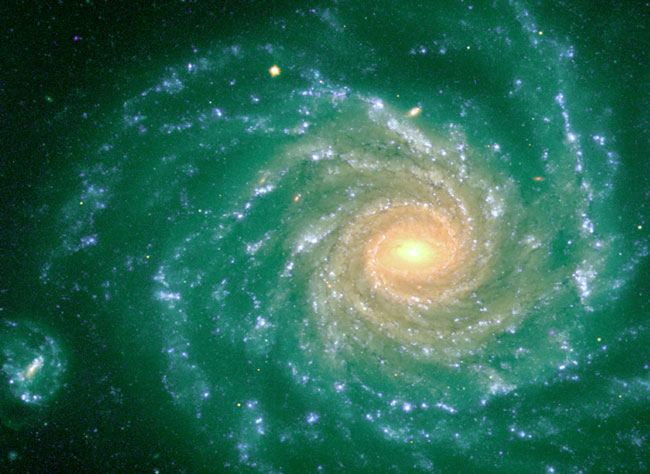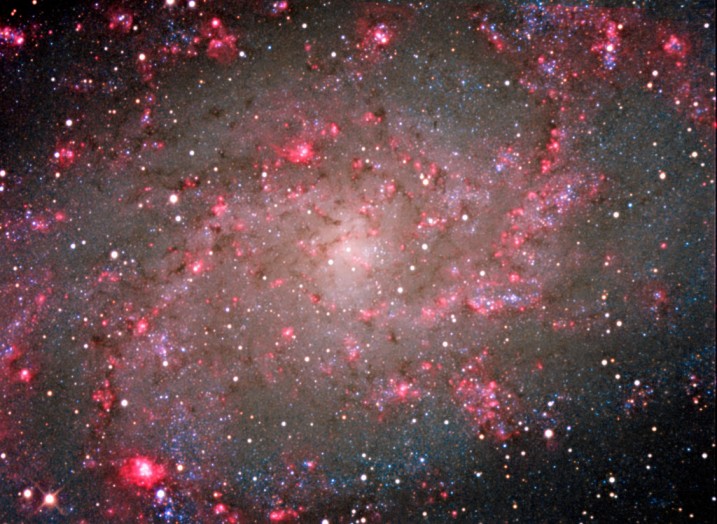 |
|
 |
 |
|
 |
Question: How can we do to penetrate the obscuring dust of our Galaxy?
Answer: Dust does not block all types of electromagnetic radiation equally. Electromagnetic radiation such as micro-waves, radio emission, x-rays, and gamma rays can penetrate the veil of dust in our Galaxy and allow us to see to the ends of the Galaxy.
Question: What kinds of electromagnetic radiation are produced in large enough amounts by the gas, dust, and stars in our Galaxy to be useful?
This is important because even if our Galaxy were transparent to gamma rays, this fact would be of no use unless objects in our Galaxy produced serious amounts of gamma rays. If they did not, then the fact that the disk was transparent to gamma rays would not be of a whole lot of use.
 |
Young stars ( OB stars, Pleiades star cluster) are bright and produce HII (ionized hydrogen) regions (Eagle Nebula). Ionized hydrogen atoms (HII) can produce radio emission. This is important because it allows us to see the HII regions (regions of recent star formation which concentrate to the spiral arms of our Galaxy) in our Galaxy. HII regions (and OB stars) are thus nice ways to trace out the spiral arms of our Galaxy.At left is the spiral galaxy M33. The bright red knots are HII regions. |
 |
HI (neutral hydrogen) regions. An important fact is that neutral hydrogen atoms, can produce radio emission. In particular, HI atoms will produce radio emission with a wavelength of 21 cm. This is good because hydrogen is the most abundant element in the Universe. Although HI is pervasive in the disk of our Galaxy, it tends to clump in clouds which concentrate toward the spiral arms of our Galaxy. The HI clouds are thus useful ways to map out the structure of our Galaxy even in regions which do not contain large amounts of normal stars.At left is a radio map (in 21 cm emission) of the Galaxy in HI emission. |
 |
Giant Molecular Clouds (star formation sites, Orion Molecular Cloud) generate micro-waves and infrared emission. Shorter in wavelength (when compared to radio emission) but longer in wavelength than visible light, micro-waves and infrared emission are useful probes of the structure of our Galaxy. It is found that Giant Molecular Clouds contain carbon monoxide (CO) molecules which emit radiation with a wavelength of 2.6 mm. |
 |
 |
 |
Cepheids (and also RR Lyrae stars) are objects which periodically vary in their power output (their luminosities). A remarkable result discovered by Henrietta Leavitt of the Harvard College Observatory was that there was well-defined relationship between the period of their pulsation and the intrinsic average brightness of the star (the period-luminosity relation). This allows Cepheids (and RR Lyraes) to be used to judge distances to far-off objects. In particular, this allowed Harlow Shapley to accurately map the positions of globular clusters and so determine the location of the Sun in the Milky Way Galaxy and to determine the size of the Milky Way Galaxy. |
Beyond showing us what the Milky Way Galaxy looks like, we can also infer another interesting feature of the disk of our Galaxy from the above structure tracers; we can map out how material moves in the disk of our Galaxy. Using the Doppler shift, we are able to determine how fast objects and gas clouds move around the center of our Galaxy. We find the following rotation curve for the Milky Way Galaxy:

The point where the visible disk of the Galaxy ends (the disk as defined by the stars) is marked on the above figure. Interestingly, we can see gas beyond the end of the star-disk of our Galaxy. We use this information in the next section to infer an interesting fact about the mass and make-up of the Milky Way galaxy.